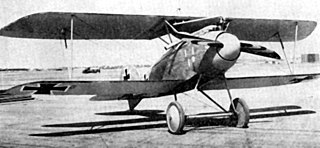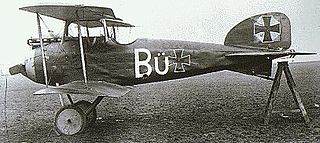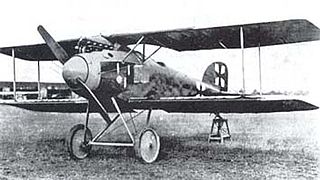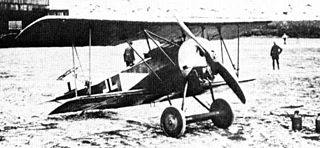
The Fokker D.VII was a German World War I fighter aircraft designed by Reinhold Platz of the Fokker-Flugzeugwerke. Germany produced around 3,300 D.VII aircraft in the second half of 1918. In service with the Luftstreitkräfte, the D.VII quickly proved itself to be a formidable aircraft. The Armistice ending the war specifically required, as the fourth clause of the "Clauses Relating to the Western Front", that Germany was required to surrender all D.VIIs to the Allies. Surviving aircraft saw much service with many countries in the years after World War I.

The Albatros C.III was a German two-seat general-purpose biplane of World War I, built by Albatros Flugzeugwerke. The C.III was a refined version of the successful Albatros C.I and was eventually produced in greater numbers than any other C-type Albatros.

The Fokker Eindecker fighters were a series of German World War I monoplane single-seat fighter aircraft designed by Dutch engineer Anthony Fokker. Developed in April 1915, the first Eindecker ("Monoplane") was the first purpose-built German fighter aircraft and the first aircraft to be fitted with a synchronization gear, enabling the pilot to fire a machine gun through the arc of the propeller without striking the blades. The Eindecker gave the German Army's Air Service (then the Fliegertruppen des deutschen Kaiserreiches) a degree of air superiority from July 1915 until early 1916. This period, during which Allied aviators regarded their poorly armed aircraft as "Fokker Fodder", became known as the "Fokker Scourge".

The Fokker E.I was the first fighter aircraft to enter service with the Fliegertruppe of the Deutsches Heer in World War I. Its arrival at the front in mid-1915 marked the start of a period known as the "Fokker Scourge" during which the E.I and its successors achieved a measure of air superiority over the Western Front.

The Fokker E.III was the main variant of the Eindecker fighter aircraft of World War I. It entered service on the Western Front in December 1915 and was also supplied to Austria-Hungary and Turkey.

The Albatros D.III was a biplane fighter aircraft used by the Imperial German Army Air Service (Luftstreitkräfte) during World War I. A modified licence model was built by Oeffag for the Austro-Hungarian Air Service (Luftfahrtruppen). The D.III was flown by many top German aces, including Wilhelm Frankl, Erich Löwenhardt, Manfred von Richthofen, Karl Emil Schäfer, Ernst Udet, and Kurt Wolff, and Austro-Hungarian ones, like Godwin von Brumowski. It was the preeminent fighter during the period of German aerial dominance known as "Bloody April" 1917.

The Albatros D.I was a German fighter aircraft used during World War I. Although its operational career was short, it was the first of the Albatros D types which equipped the bulk of the German and Austrian fighter squadrons (Jagdstaffeln) for the last two years of the war.

The Albatros D.II was a German fighter aircraft used during World War I. After a successful combat career in the early Jagdstaffeln, it was gradually superseded by the Albatros D.III.

The Albatros D.V was a fighter aircraft built by the Albatros Flugzeugwerke and used by the Luftstreitkräfte during World War I. The D.V was the final development of the Albatros D.I family and the last Albatros fighter to see operational service. Despite its well-known shortcomings and general obsolescence, approximately 900 D.V and 1,612 D.Va aircraft were built before production halted in April 1918. The D.Va continued in operational service until the end of the war.

The Aviatik (Berg) D.I, was a single-engine, single-seater biplane fighter that was developed and manufactured by the Austro-Hungarian branch of German aircraft company Aviatik. It was also known as Berg D.I or the Berg Fighter, because it was designed by Dipl. Ing. Julius von Berg, and to distinguish it from the D.I fighter built by the parent Aviatik firm in Germany.

The Albatros W.4 was a German floatplane derivative of the Albatros D.I fighter with new wing and tail surfaces of greater span than the D.I. One hundred eighteen examples were built between June 1916 and December 1917. The aircraft operated in the North Sea and Baltic theatres and later served as training aircraft.

The Halberstadt D.II was a biplane fighter aircraft developed and manufactured by German aircraft company Halberstädter Flugzeugwerke.

The LFG Roland C.II, usually known as the Walfisch (Whale), was an advanced German reconnaissance aircraft of World War I. It was manufactured by Luft-Fahrzeug-Gesellschaft G.m.b.H.

The Fokker D.VI was a German fighter aircraft built in limited numbers at the end of World War I. The D.VI served in the German and Austro-Hungarian air services.

The Fokker D.II was a German fighter biplane of World War I. It was a single-seat fighter aircraft developed before the Fokker D.I. It was based on the M.17 prototype, with single-bay unstaggered wings and a larger fuselage and shorter span than production D.IIs. Using a 75 kW (100 hp) Oberursel U.I, the D.II was underpowered, though the single 7.92 mm (.312 in) lMG 08 machine gun was normal for 1916. The German Army purchased 177.

The Hansa-Brandenburg C.I, also known as Type LDD, was a 2-seater armed single-engine reconnaissance biplane designed by Ernst Heinkel, who worked at that time for the parent company in Germany. The C.I had similarities with the earlier B.I, including inward-sloping interplane bracing struts. Like other early-war Austro-Hungarian reconnaissance aircraft, such as C-types of Lloyd or Lohner, the Type LDD had a communal cockpit for its crew.

The Hansa-Brandenburg CC was a single-seat German fighter flying boat of World War I. It was used by both the Kaiserliche Marine and the Austro-Hungarian Navy.

The Hansa-Brandenburg D.I, also known as the KD was a German fighter aircraft of World War I. Despite poor handling characteristics it was put into service by Austria-Hungary, where some aircraft served until the end of the war.
The Aviatik (Berg) D.II, the prototypes of which were known as Aviatik 30.22 and Aviatik 30.38, was an Austro-Hungarian fighter plane prototype towards the end of the First World War.

The Lohner Type AA were a series of prototype fighters built during World War I. The program would eventually be cancelled due to inherent instability concerns of the design.




















